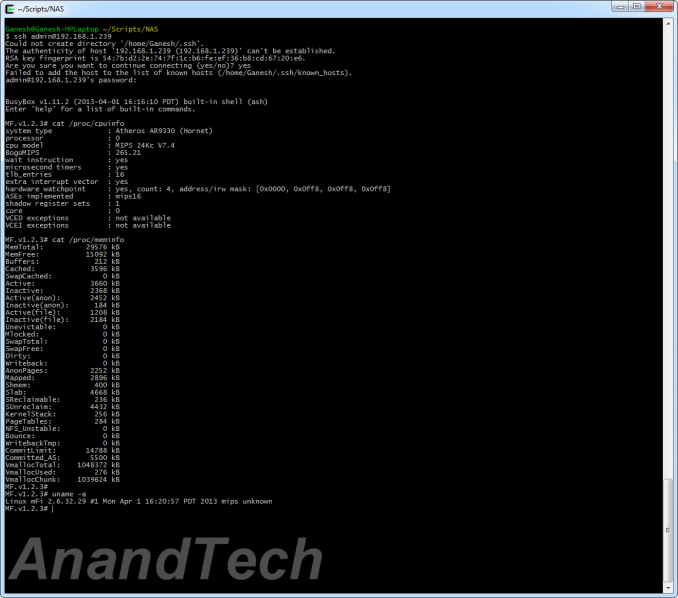Ubiquiti Networks mFi mPower Wi-Fi Power Strip Review
by Ganesh T S on November 21, 2013 3:00 AM EST- Posted in
- Home Automation
- Wi-Fi
- Ubiquiti Networks
- IoT
Inside the mPower
The mPower can be accessed and controlled via SSH even without linking it with a mFi host. In this case, the SSH login credentials are the default (ubnt/ubnt). The mPower unit runs Linux under its hood, with BusyBox providing much of the needed access functionality. The unit uses the Dropbear SSH server service. Accessing the unit over SSH gives us some insight into the core platform.
The mPower uses the Atheros AR9330 Hornet platform (more commonly found in wireless access points / low end routers such as this one) for its networking functionality and host CPU. The unit has 16 MB of RAM. The more interesting aspect is the chip used for collecting the electrical parameters. Ubiquiti takes pride in the fact that the electrical statistics are gathered by utility-grade ICs rather than the ADCs employed by other competing solutions. The mPower uses the Prolific PL7223 for gathering the electrical parameters. The PL7223 is apparently popular in these circles, as it also finds a place in GainSpan's SmartPlug kit. At this price point, it would be unfair to expect solid-state relays. So, we do have the clicking sounds when outlets are turned on or off.
FCC reports for all of Ubiquiti's products are linked on this page. We could have torn down the mPower unit ourselves, but, with the details of the platform evident from gaining SSH access, we leave it to the photographs provided in the FCC submission. They are reproduced in the gallery below.
In the next section, we will look into taking advantage of SSH for the development of custom applications.

















61 Comments
View All Comments
bznotins - Tuesday, December 10, 2013 - link
So I ordered this from Amazon and have been generally impressed. A few problems, though, one which is quite ironic.The ironic one first. One of the reasons I bought this tool to help measure my power usage and ultimately reduce it. My home server is basically a Win8.1 box with TeamViewer access. It remains on 24/7 (except for the once a month when it hard locks and I have to power-cycle it, which is the other reason for this mFi power bar). Anyways, my home server generally uses 30W at idle. The simple act of installing the Win8 mFi home server software pushes the CPU utilization up so that it's no longer in low-power idle and my server consumes 60W (as measured by the same power bar, heh). So just tracking my power using the server doubles the consumption of my home server.
Thankfully the mFi server software can be shut down so that it doesn't run 24/7 and the power bar can still be accessed via its IP. And it works great in that case. Easy to turn each outlet off if necessary both from LAN and WAN (using port forwarding on my router).
My other problem with the unit is that it is connected to my home network AND broadcasting its unsecured adhoc network at the same time. There is no apparent way to disable the latter once the former is running. I thought that it would be automatic. In fact, I didn't think it was possible for the device to be connected to my home network and broadcasting an adhoc network simultaneously, but it is. I plan to mess with this further as the device isn't terribly friendly to novices like me.
Overall I'm happy because it does what I need it to, but there are still some issues.